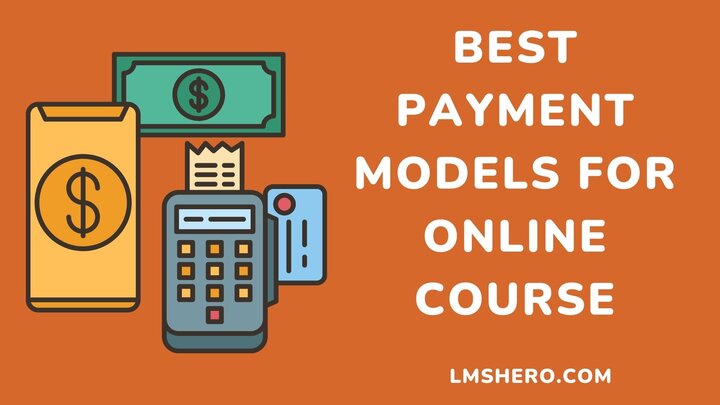If you’re an online creator looking for the best payment model that matches your specific needs and budget. In this article, I will go over 9 of the best payment models used by most online courses.
Take your time to read the entire article to determine the best payment models you can use for your online course.
The Best Payment Models For Online Courses
Unfortunately, with so many payment models to choose from, finding the right one can be a difficult task.
Depending on your courses, here are the best payment method you can choose from;
1. One-Time Payment
This payment model for online courses is very straightforward, and it’s a good place to start, especially for passive courses. Those learning programs that don’t add any additional value as time passes.
As an online course creator, your students will only have to pay once to gain access to the course materials. Therefore, they need to pay for the program in order to enroll for the course.

After the students pay the fee and gain access to the learning materials, they will be able to review the course as many times as they want without incurring additional costs.
One-time payments are quick and convenient. Because your students don’t have to make reoccurring payments every month or regularly, as they would with subscriptions.
However, the only materials the students will have access to are those for the course that they signed up for. If they liked how the course went and want to enroll in another program on the same platform they will have to pay.
2. Pay Per User
This is a free structure that requires each person who enrolls or uses the LMS to pay, and normally, the system is cloud-based. In other words, you are fully responsible for whatever LMS platform you choose.
This means students will be able to take advantage of more free extra services. In other words, you are responsible for regularly upgrading and updating the content as well as the platform.
This payment model allows your students to take advantage of courses that are already uploaded on an LMS platform. It is ideal for groups of students.
3. Flat Recurring Payment
Interested students and learners might need to pay a daily, monthly, or weekly fee in this case. Some courses even require students to pay for them on an annual basis. The concept is as follows: the sum remains constant each time it recurs.
If you’re thinking of choosing this payment model, you should do so only if the program you’re offering provides regularly added value.
Webinars and coaching sessions are two of the most common examples. Flat recurring payments are typically supported by automated processes that make them simple, convenient, and time-saving.
It is suitable for a wide range of students, from individual students to groups and employees of businesses, due to its features.
4. Pay Per Registered User
This payment model works well if your target audience is companies that need to train their employees in a group setting. For each additional user, who registers, the company will be charged a fee. You must also create an account for each user, complete with a login name and password.
It’s the best payment option for businesses because payment is made securely and conveniently. Early bird discounts are available, and registration can be tailored to the user’s specific needs.
5. Payment Plans
Payment plans are frequently used in conjunction with one-time payments. Assume that course creators offer $500 one-time payment plans. In that case, they might offer a $350 three-month payment plan.
Your students will benefit from this option because they will pay a lower monthly fee. Learners will have lifetime access to all materials, even if there is no trial offer.
Payment plans also serve as relationship builders, meaning that users are more likely to receive multiple offers, reward points, and perks. Most payment plans work automatically, so students’ credit cards will be charged on a monthly or annual basis.
6. Pay Per Active User
This option is suitable for groups of learners, and it is a cost-effective payment option for clients because they will only be charged for users who are active on the LMS.
When it comes to the pay-per-active-user system, there are typically two approaches. The first refers to being billed for each user who logs in during the billing cycle.
These users will be able to browse the entire training course catalog without incurring any additional fees once they have registered on the platform.
The second method involves charging monthly fees for each active user. For a business looking to enroll multiple employees in your training program, they’ll only be charged for active users.
This means your clients/students won’t be wasting money on inactive accounts. Therefore, the payment method encourages businesses to take more risks.
7. Free With Membership
This payment model for online courses is frequently used for online classes that are sold separately. These programs, as well as other courses and non-LMS content such as web pages and posts, are included in the membership.
The most basic example is a platform that allows educational programs to be bundled and sold as a single membership. If your student purchases a membership, they will have access to all the lectures for free.
Most online users prefer this payment model because it provides them with a sense of security, familiarity, and convenience.
Some people may be perplexed by the fact that the method’s name includes the word “free,” but the course isn’t free. To gain access to the program, your students must first become a member, which some people may not appreciate.
8. Members-Only Pricing
This payment model is the best option for online training that will only be available to subscribed users. In addition, those who have already subscribed may receive significant discounts, price offers, and gifts in the form of e-books, etc.
Customers benefit greatly from members-only pricing. Users will be able to take advantage of a variety of perks, promotional offers, and other important features that aren’t available elsewhere.
9. The $1 Trial or The Free Trial
One-dollar trials provide low-cost access to a course or membership. But after a certain period, students will be charged a larger one-time or recurring payment.
If you have a lot to prove and need to earn the trust of your customers, a dollar trial or a free trial might be a good idea.
FAQs
Which online payment mode is best?
PayPal is the most popular online payment mode, and for good reason.
It’s fast, secure, and easy to use. Plus, your customers can pay with their bank cards or credit cards, which gives them more options and makes it easier for them to purchase your products.
Which platform is best for online classes?
Depending on your needs, some of the best platforms include Coursera, Udemy, Udacity, Skillshare, and edX.
Conclusion: Best Payment Models for Online Courses
There are many payment models available for online courses. Which one is appropriate for your course depends on a variety of factors, including your audience, the type of content you are providing, and the technology you are using.
There is no right or wrong answer; you just need to decide which model will work best for your course. If a course or program adds value regularly, then using one of the recurring models is your best option.
A trial version, on the other hand, should be your preferred option if you’re afraid of taking risks and want to see how well a course performs.
I hope you found this article helpful. You also see these effective tips for creating profitable online courses.
Thanks for reading.






